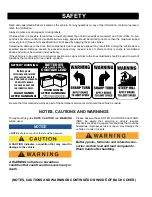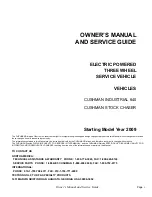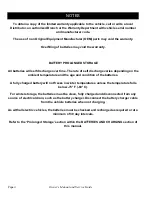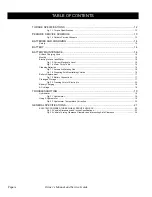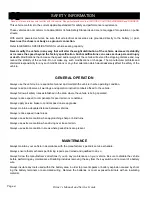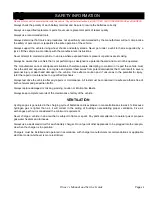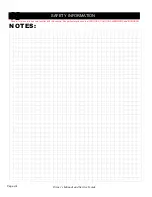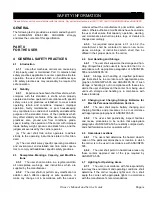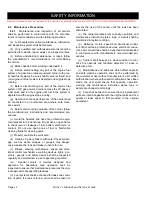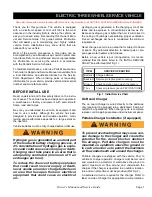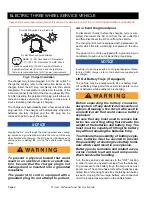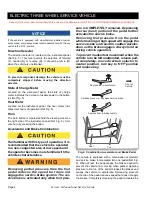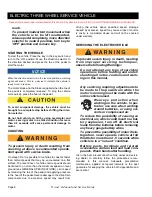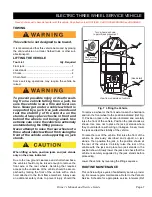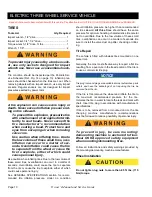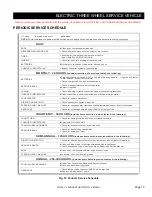
SAFETY INFORMATION
Page x
Owner’s Manual and Service Guide
Read all of manual to become familiar with this vehicle. Pay particular attention to all NOTICES, CAUTIONS,WARNINGS and DANGERS.
4.8
Control of Noxious Gases and Fumes
4.8.1
When equipment powered by internal com-
bustion engines is used in enclosed areas, the atmo-
sphere shall be maintained within limits specified in the
American Conference of Governmental Industrial
Hygienists publication, “Threshold Limit Values for
Chemical Substances and Physical Agents in the Work-
room Environment”. This shall be accomplished by venti-
lation provided by the user, and/or the installation, use,
and proper maintenance of emission control equipment
recommended or provided by the manufacturer of the
equipment.
4.9
Warning Device(s)
4.9.1
The user shall make periodic inspections of
the carrier to be certain that the sound-producing and/or
visual device(s) are maintained in good operating condi-
tion.
4.9.2
The user shall determine if operating condi-
tions require the carrier to be equipped with additional
sound-producing and/or visual devices and be responsi-
ble for providing and maintaining such devices, in accor-
dance with the manufacturer’s recommendations.
5 OPERATING SAFETY RULES AND
PRACTICES
5.1
Personnel and Burden Carrier Operator
Qualifications
5.1.1
Only persons who are trained in the proper
operation of the carrier shall be authorized to operate the
carrier. Operators shall be qualified as to visual, auditory,
physical, and mental ability to safely operate the equip-
ment according to Section 5 and all other applicable
parts of this Standard.
5.2
Personnel and Burden Carrier Operators’
Training
5.2.1
The user shall conduct an operators’ training
program.
5.2.2
Successful completion of the operators’ train-
ing program shall be required by the user before opera-
tion of the carrier. The program shall be presented in its
entirety to all new operators and not condensed for those
claiming previous experience.
5.2.3
The user should include in the operators’ train-
ing program the following:
(a) instructional material provided by the manufac-
turer;
(b) emphasis on safety of passengers, material loads,
carrier operator, and other employees;
(c) general safety rules contained within this Standard
and the additional specific rules determined by the user
in accordance with this Standard, and why they were for-
mulated;
(d) introduction of equipment, control locations and
functions, and explanation of how they work when used
properly and when used improperly, and surface condi-
tions, grade, and other conditions of the environment in
which the carrier is to be operated;
(e) operational performance tests and evaluations dur-
ing, and at completion of, the program.
5.3
Personnel and Burden Carrier Operator
Responsibility
5.3.1
Operators shall abide by the following safety
rules and practices in paras. 5.4, 5.5, 5.6, and 5.7.
5.4
General
5.4.1
Safeguard the pedestrians at all times. Do not
drive carrier in a manner that would endanger anyone.
5.4.2
Riding on the carrier by persons other than the
operator is authorized only on personnel seat(s) provided
by the manufacturer. All parts of the body shall remain
within the plan view outline of the carrier.
5.4.3
When a carrier is to be left unattended, stop
carrier, apply the parking brake, stop the engine or turn
off power, turn off the control or ignition circuit, and
remove the key if provided. Block the wheels if machine
is on an incline.
5.4.4
A carrier is considered unattended when the
operator is 25 ft. (7.6 m) or more from the carrier which
remains in his view, or whenever the operator leaves the
carrier and it is not within his view. When the operator is
dismounted and within 25 ft. (7.6 m) of the carrier still in
his view, he still must have controls neutralized, and the
parking brake(s) set to prevent movement.
5.4.5
Maintain a safe distance from the edge of
ramps and platforms.
5.4.6
Use only approved carriers in hazardous loca-
tions, as defined in the appropriate safety standards.
5.4.7
Report all accidents involving personnel,
building structures, and equipment.
5.4.8
Operators shall not add to, or modify, the car-
rier.


